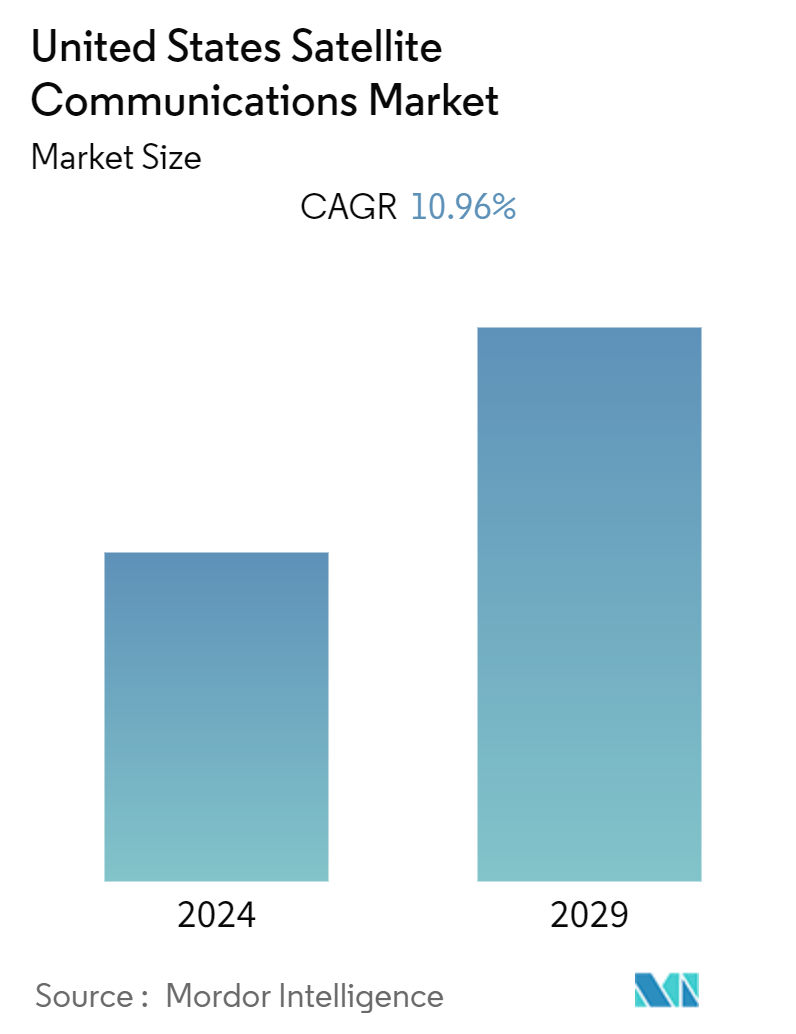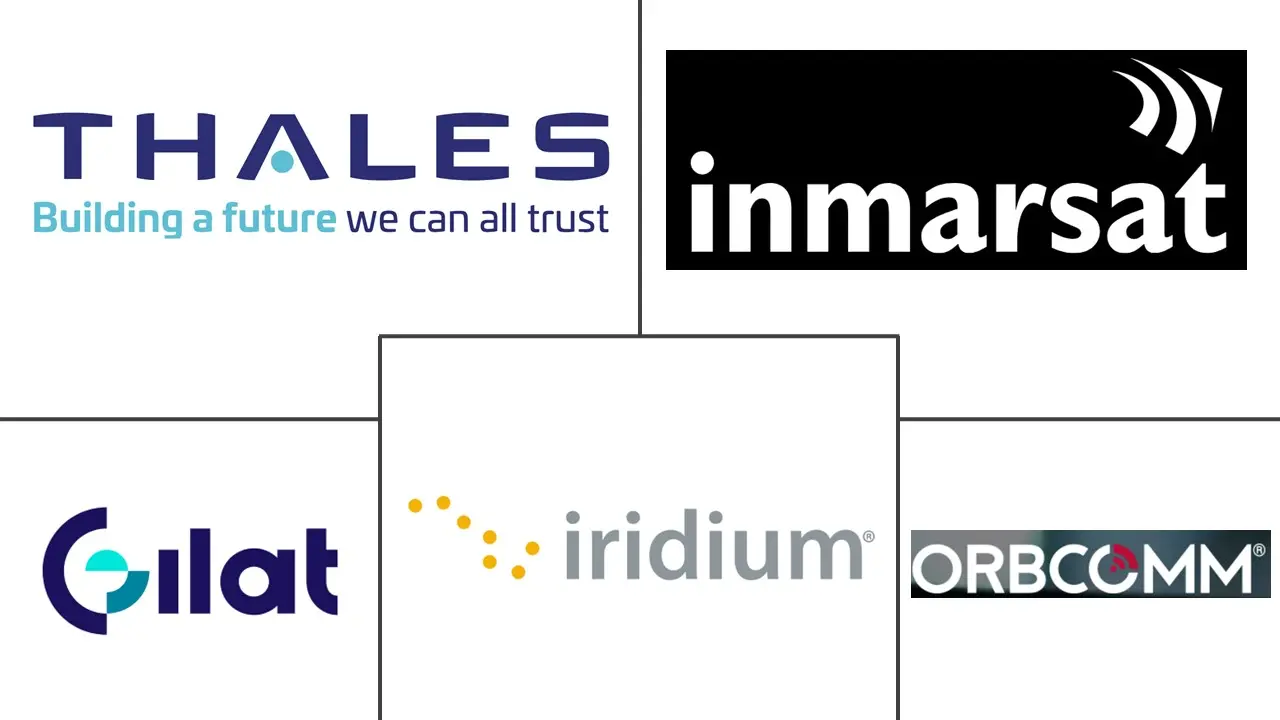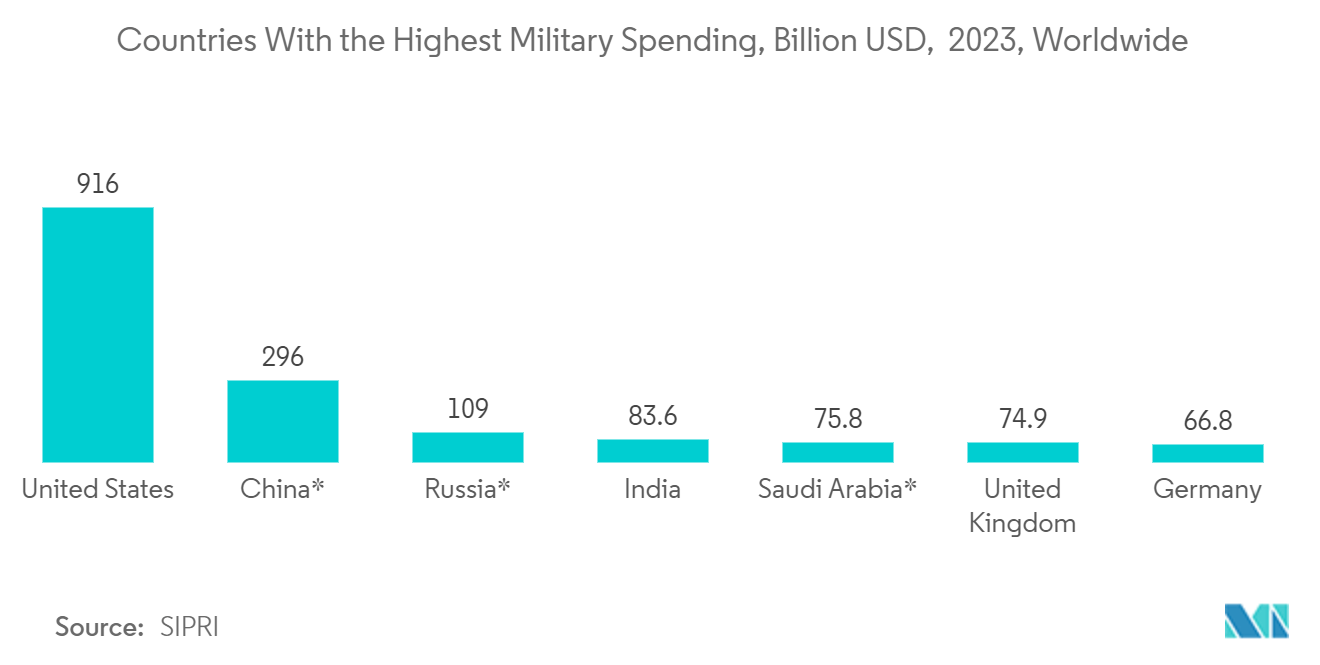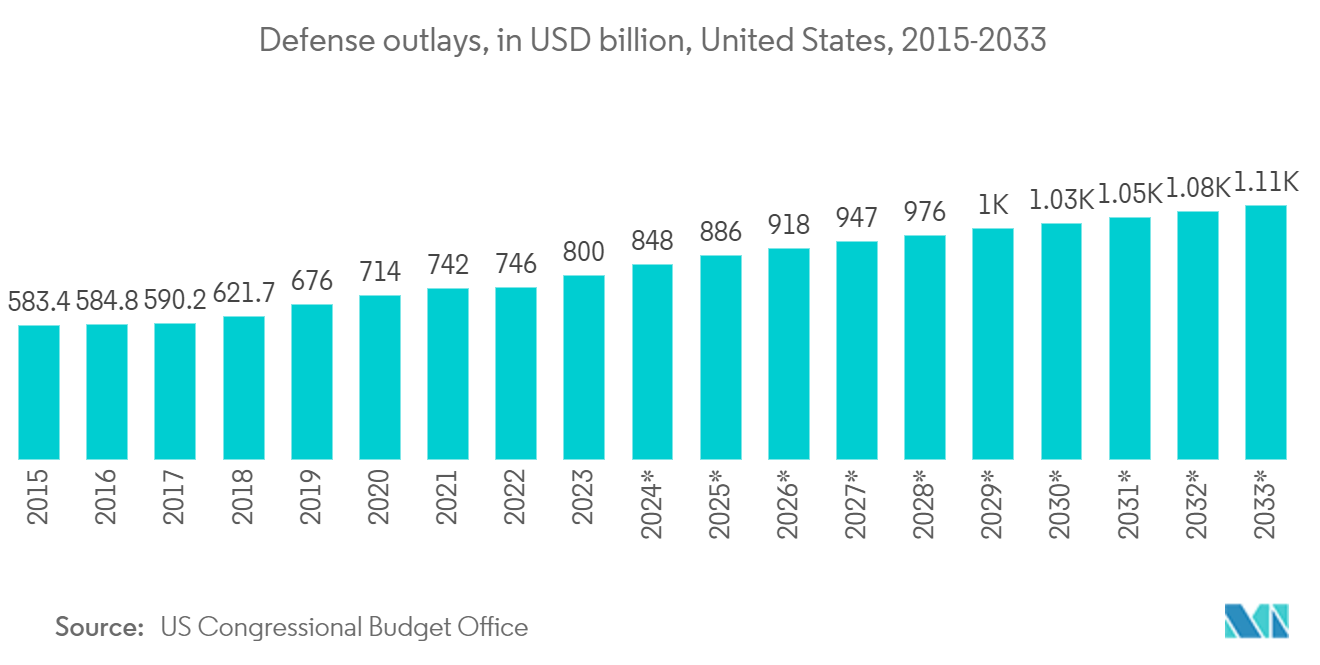United States Satellite Communications Market Size

| Study Period | 2019 - 2029 |
| Base Year For Estimation | 2023 |
| Forecast Data Period | 2024 - 2029 |
| Historical Data Period | 2019 - 2022 |
| CAGR (2024 - 2029) | 10.96 % |
| Market Concentration | Medium |
Major Players
*Disclaimer: Major Players sorted in no particular order |
United States Satellite Communications Market Analysis
The United States Satellite Communications Market is expected to register a CAGR of 10.96% during the forecast period.
Satellite communication is used for various applications across industries, such as media broadcasting, an extension of broadband coverage, 5G communications systems, integration and convergence of diverse wired and wireless technologies, earth observation, defense and security, and surveillance applications.
- The demand for broadband communications remains strong and is not necessarily geographically restricted. Such demands include connectivity requirements for users on aircraft, ships, and vehicles (including first responders) operating in fixed places and while in motion. These three platforms require constant connectivity along their travel itineraries, frequently passing through underserved sections of major metropolitan centers and less heavily inhabited areas. Such developments are projected to aid in the market's growth under consideration.
- Changes in satellite communications and telecommunications and computer systems advancements have created new opportunities in the sector's innovative areas. As industrial production facilities and mining operations expand into more inhospitable terrains, the need for efficient wireless connections via terrestrial and satellite communications grows.
- Satellite IoT applications can be found in various industries, ranging from the marine market to machine-to-machine (M2M) applications in transportation, agriculture, oil and gas, utilities, and construction, among many others. For instance, to better understand how satellite IoT is employed in the heavy equipment business.
- Several of the most extensive heavy equipment Original Equipment Manufacturers (OEMs) use Iridium's satellite IoT solutions to monitor and manage deployed assets remotely. Kobelco Construction Machinery (KCM), for example, recently collaborated with Iridium to incorporate Iridium's two-way satellite communications into its hydraulic excavator machinery, heavy equipment, and remote asset management platform. KCM equipment now has genuinely worldwide coverage for the first time due to the integration of Iridium IoT services.
- Direct broadcasting or satellite television has become a significant form of distribution for television content. The broad and controllable coverage areas and much larger bandwidths enable more channels to be broadcast, making satellite television very attractive. But the main drawback is that satellites cannot transmit very high-powered signals, and combined with the path loss from geostationary orbit; the signal levels are low. This indicates that directive antennas must provide sufficient gain while receiving signals from only one satellite. Several satellites could be visible from one location and broadcast on the same frequencies.
- A parabolic reflector antenna can meet these needs and has the added advantage that it would not be as long as a Yagi for an equivalent level of gain and directivity. The parabolic reflector antenna is often used as a broadcast satellite receive antenna. A parabolic reflector antenna realizes high gain and low sidelobe by converting the spherical wave radiated by a primary radiator to the plane wave.
- On the flip side, Cybersecurity has become a major concern for satellite communication as launching a satellite to transmit data is compassionate. Further, the challenge lies in the negative impact that such cybersecurity threats can potentially make, as the vulnerabilities are mission-critical. The mission-critical vulnerabilities exposed to cybersecurity threats include the launch systems, communications, telemetry, tracking and command, and mission completion. The over-dependency of satellite communication on secure cyber capabilities across the satellite's lifespan makes it a serious concern, hindering its adoption.
United States Satellite Communications Market Trends
Maritime is Expected to Hold Significant Share
- The United States government policies or investment in the maritime industry is expected to drive the studied market. For instance, The Bipartisan Infrastructure Law (BIL) President Biden signed into law recently delivered a once-in-a-generation USD 1.2 trillion investment in the nation's infrastructure and competitiveness. In the maritime industry, the BIL invests more than USD 17 billion in port infrastructure and waterways with the main goals of addressing backlogs in needed repairs and maintenance, reducing traffic to strengthen supply chains and removing bottlenecks to speed up commerce, reducing emissions near ports by boosting electrification, and investing in other low-carbon technologies to reduce environmental impacts on nearby communities.
- Moreover, in August 2022, Inmarsat Government announced that the Defense Information Systems Agency (DISA) had given it the Next Generation Wideband (NGW) Follow-On (FO) Contract from the U.S. Navy Military Sealift Command (MSC) for global end-to-end commercial satellite communications services. The ceiling value of the award under this Indefinite-Delivery, Indefinite Quantity (IDIQ) contract is USD 578 Million over a ten-year term. Inmarsat Government will manage and run commercial communications infrastructures, such as satellite systems, teleport services, and terrestrial services, as part of the deal.
- The players in the market are providing new products to cater to a wide range of needs of customers. For instance, in July 2022, KVH Introduced KVH ONE Hybrid Network and Groundbreaking TracNetTerminals. Innovative terminals feature integrated satellite, cellular, and Wi-Fi technology with intelligent, automatic switching to keep boats connected to the best available communication option for fast, reliable sea and dock connectivity.
- Mobile Satellite communication enables the delivery of high bandwidth, which also helps in better data and voice transfers, simultaneously serving most other purposes. In July 2022, SpaceX launched the Starlink service into the maritime sector. The service would offer high-speed, low-latency internet with download speeds of up to 350 Mbps at sea. Starlink Maritime was designed for merchant ships, oil rigs, yachts, and others, delivering connectivity from remote locations at sea. Later, the service provider applied for more spectrum to upgrade Starlink satellite broadband services for mobile users in July. SpaceX asked the U.S. Federal Communications Commission for permission to use the 2 GHz spectrum band to 'augment' its mobile satellite services (MSS).
- According to the Union of Concerned Scientists, as of April 30, 2022, the United States had 3,433 operational artificial satellites circling the Earth. This is by far the most amount of any country, with China accounting for only 541. Moreover, satellite communication services offer secure bandwidth capacity for military operations in remote areas with insufficient and unstable communications infrastructure. In the upcoming years, the income from Fixed Satellite Services (FSS) utilized in government and military applications is projected to increase significantly in the North American region.

Defense and Government is Expected to Hold Significant Share of the Market
- To command and control forces, monitor opponent actions, and uncover threats that could jeopardize the United States and its allies, the US Department of Defense (DoD) relies on the advantages afforded by satellites for nearly every military mission. As per the Union of Concerned Scientists, out of 4,852 active artificial satellites orbiting the Earth, 2,944 belongs to the United States as of January 1, 2022. The United States Space Force (USSF) operates the USD 6.8 billion Satellite Control Network (SCN) for military warfighters, which consists of a global ground network of fixed antennas at seven sites to command more than 190 military and government satellites.
- Government agencies in North America have been making significant efforts to introduce new satellite and navigation systems that boosted the growth of the satellite communication industry. North America has a large coastal area that requires continuous monitoring. The increasing commercial activities and trade in the region are propelling the need for maritime safety and surveillance.
- The US coastal waters are most vulnerable due to its open borders. This nature of the vast maritime domain of the United States faces critical threats from terrorism, criminal activities, and natural disasters. The underlying threat poses unique and critical challenges in enforcing maritime safety, as illegal activities can happen from all directions across the country's maritime borders if there is no proper system for detection and identification. The factors mentioned above are anticipated to influence the market studied in the region during the forecast period.
- The country launched its fifth Advanced Extremely High-Frequency spacecraft (AEHF-5). This secured military communications satellite will provide jam-proof communications between US national leadership and deployed military forces, including real-time video. The United States has the world's largest military spending. The Senate Armed Services Committee approved a defense budget for FY2022 that was USD 25 billion higher than the President's proposal. The National Defense Authorization Act, with a defense budget of USD 740 billion.
- According to US Congressional Budget Office, Defence spending in the United States is expected to rise annually until 2033. Defense spending in the United States is expected to reach USD 746 billion in 2023. According to the prediction, defense spending is expected to rise to 1.1 trillion US dollars by 2033. Such huge spending by the government would create an opportunity for the studied market to grow and allow the players to develop new products to cater a wide range of needs of customers.

United States Satellite Communications Industry Overview
The United States satellite communications market is semiconsolidated, with a few prominent players such as Iridium Communications Inc, ORBCOMM Inc., Viasat Inc., and other corporations continually spending on strategic partnerships and product development to increase market share. The following are some recent market developments:
In January 2023, Viasat Inc., a worldwide communications firm, said it had been granted a contract to support end-to-end satellite communications (SATCOM) to the United States Marine Corps (USMC) via a fully managed service. The contract is an extension of a successful pilot and follow-on service program in which Viasat delivered a fully managed SATCOM as a Managed Service (SaaMS) solution to the USMC I Marine Expeditionary Force (I MEF), the Marine Corps' largest warfighting organization, in fiscal year 22. This is a USMC command's first use of a commercially developed SaaMS.
In August 2022, SpaceLink announced that it would collaborate with the Defence Advanced Research Projects Agency to create protocols for connecting commercial communications constellations to defense and military equipment. DARPA launched a new initiative named Space BACN (space-based adaptive communications node) earlier this month to construct low-cost optical lines to connect commercial and government constellations. The agency seeks to build a network of low-Earth orbit satellites that will allow seamless communication across military, civil, and private-sector satellite networks that are now incompatible.
United States Satellite Communications Market Leaders
-
Thales Group
-
Inmarsat Global Limited
-
Iridium Communications Inc
-
Gilat Satellite Networks Ltd
-
Orbcomm Inc
*Disclaimer: Major Players sorted in no particular order

United States Satellite Communications Market News
October 2022: A United States Government Agency has awarded ORBCOMM Inc. a multi-year contract for its global Automatic Identification System (AIS) data services, which are utilized for ship monitoring and other marine navigational and safety initiatives. Additionally, ORBCOMM secured a different, competitive contract to provide AIS services to several additional United States Government users.
July 2022: KVH Industries, Inc. announced TracNetTM terminals and KVH ONETM hybrid network for quick, dependable sea and land communication. The satellite, cellular, and Wi-Fi technologies are all combined in one dome on the TracNet H30, H60, and H90 terminals, with intelligent, automated switching depending on the accessibility, cost, and quality of the data connection to continuously give the optimum performance.
United States Satellite Communications Market Market Report - Table of Contents
1. INTRODUCTION
- 1.1 Study Assumptions and Market Definition
- 1.2 Scope of the Study
2. RESEARCH METHODOLOGY
3. EXECUTIVE SUMMARY
4. MARKET INSIGHTS
- 4.1 Market Overview
-
4.2 Industry Attractiveness - Porter's Five Forces Analysis
- 4.2.1 Bargaining Power of Buyers
- 4.2.2 Bargaining Power of Suppliers
- 4.2.3 Threat of New Entrants
- 4.2.4 Threat of Substitutes
- 4.2.5 Intensity of Competitive Rivalry
- 4.3 Industry Value Chain Analysis
- 4.4 Assessment of the Impact of COVID-19 on the Market
5. MARKET DYNAMICS
-
5.1 Market Drivers
- 5.1.1 Increase in Internet of Things (IoT) and Autonomous Systems
- 5.1.2 Rise in Demand for Military and Defense Satellite Communication Solutions
-
5.2 Market Restraints
- 5.2.1 Increasing Costs Associated with Complexity
- 5.2.2 Interference in Transmission of Data
6. MARKET SEGMENTATION
-
6.1 By Type
- 6.1.1 Ground Equipment
- 6.1.2 Services
-
6.2 By Platform
- 6.2.1 Portable
- 6.2.2 Land
- 6.2.3 Maritime
- 6.2.4 Airborne
-
6.3 By End-user Vertical
- 6.3.1 Maritime
- 6.3.2 Defense and Government
- 6.3.3 Enterprises
- 6.3.4 Media and Entertainment
- 6.3.5 Other End-user Verticals
7. COMPETITIVE LANDSCAPE
-
7.1 Company Profiles*
- 7.1.1 Thales Group
- 7.1.2 Inmarsat Global Limited
- 7.1.3 Iridium Communications Inc
- 7.1.4 Gilat Satellite Networks Ltd
- 7.1.5 Orbcomm Inc
- 7.1.6 Cobham Satcom (Cobham Limited)
- 7.1.7 Viasat Inc.
- 7.1.8 L3Harris Technologies Inc.
- 7.1.9 KVH Industries Inc.
- 7.1.10 Spire Global Inc
8. INVESTMENT ANALYSIS
9. MARKET OPPORTUNITIES AND FUTURE TRENDS
** Subject To AvailablityUnited States Satellite Communications Industry Segmentation
Satellite communication is data transmission from one location to another using a communication satellite in orbit around the Earth. A communication satellite is a man-made spacecraft that sends a signal via a transponder by establishing a channel between the transmitter and the receiver at separate Earth locations.
The United States satellite communications market is segmented by type ( ground equipment, services), by platform (portable, land, maritime, airborne), by end-user vertical (maritime, defense and government, enterprises, media and entertainment).
The market sizes and forecasts are provided in terms of value (USD) for all the above segments.
| By Type | Ground Equipment |
| Services | |
| By Platform | Portable |
| Land | |
| Maritime | |
| Airborne | |
| By End-user Vertical | Maritime |
| Defense and Government | |
| Enterprises | |
| Media and Entertainment | |
| Other End-user Verticals |
United States Satellite Communications Market Market Research Faqs
What is the current United States Satellite Communications Market size?
The United States Satellite Communications Market is projected to register a CAGR of 10.96% during the forecast period (2024-2029)
Who are the key players in United States Satellite Communications Market?
Thales Group, Inmarsat Global Limited, Iridium Communications Inc, Gilat Satellite Networks Ltd and Orbcomm Inc are the major companies operating in the United States Satellite Communications Market.
What years does this United States Satellite Communications Market cover?
The report covers the United States Satellite Communications Market historical market size for years: 2019, 2020, 2021, 2022 and 2023. The report also forecasts the United States Satellite Communications Market size for years: 2024, 2025, 2026, 2027, 2028 and 2029.
United States Satellite Communications Market Industry Report
Statistics for the 2024 United States Satellite Communications market share, size and revenue growth rate, created by Mordor Intelligence™ Industry Reports. United States Satellite Communications analysis includes a market forecast outlook to for 2024 to 2029 and historical overview. Get a sample of this industry analysis as a free report PDF download.



